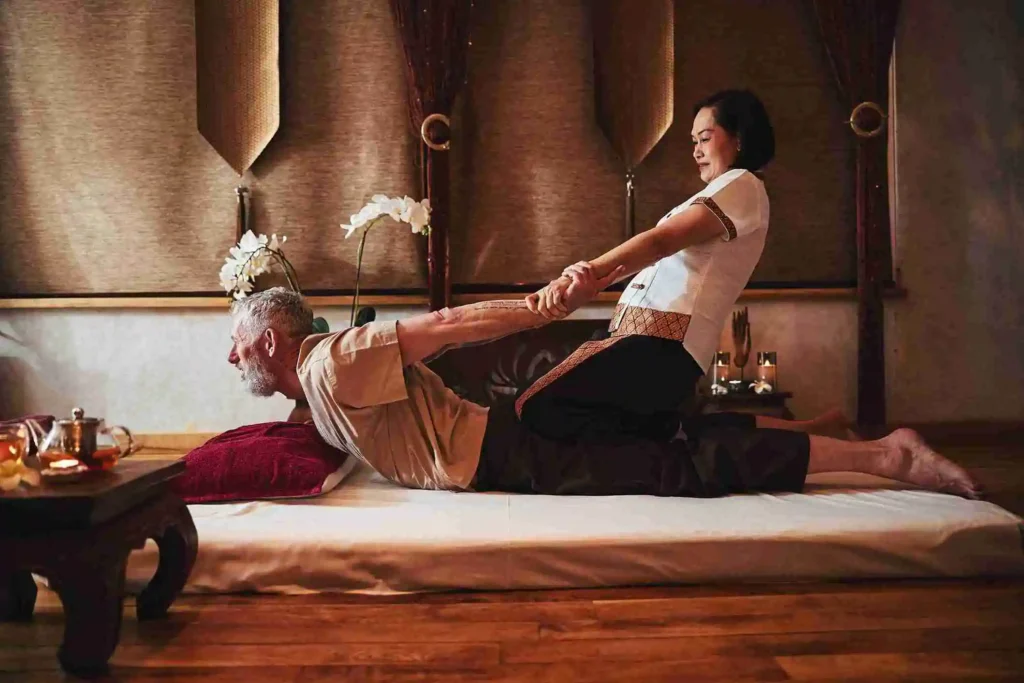THAI YOGA MASSAGE

Medical Massage Therapist Sujatha G's Thai Yoga Massage: An Original Combining of Massage and Yoga
Having more than forty years of experience as a therapist, I have had the honor of teaching and practicing several massage forms. Thai Yoga Massage is one kind of treatment with great popularity for its great advantages. Many times, this age-old healing technique is explained as combining yoga, aided stretching, and massage. Unlike traditional massages, Thai Yoga Massage emphasizes energy lines and utilizes the power of movement and pressure to deeply heal the body and mind. If you’re curious about this unique and rejuvenating therapy, let me walk you through what Thai Yoga Massage is, its benefits, and how to get the most out of your experience.
Thai Yoga Massage is what?
Thai Yoga Massage is a traditional healing method that originated in Thailand and is strongly founded in the ancient principles of Thai medicine and yoga. Often called “nuad boran, or “ancient massage,” it combines assisted stretching with deep breathing, gentle rocking, acupressure, to foster overall well-being.
During a Thai Yoga Massage session, the therapist uses their hands, forearms, elbows, knees, and feet to apply pressure along the body’s energy channels, also known as Sen lines. These lines are supposed to be routes for the body’s vital energy (similar to the meridians in Traditional Chinese Medicine). The massage helps to free blockages, release tension, and restore balance inside the body by gently stretching the body and pressing these lines.
Thai Yoga Massage is usually done on a mat on the floor, with the recipient completely clothed in loose, comfortable clothing that lets for movement, unlike other massage techniques usually involving a table.
Benefits of Thai Yoga Massage
- Flexibility and Mobility: The increase of flexibility is one of the main advantages of Thai Yoga Massages. The therapist helps you to gently, yoga-like stretches opening the body and enhancing its range of motion. It’s especially good for folks with tight muscles or poor flexibility.
- Relief from Stress and Anxiety: Like other forms of massage, Thai Yoga Massage works to relax the body and mind. The rhythmic, flowing movements and pressure points stimulate the parasympathetic nervous system, helping to lower cortisol levels, reduce stress, and induce deep relaxation.
- Pressure applied along the energy lines and the stretches help release chronic muscular tension, so relieving pain, and so lowering muscle stiffness. Those with back problems, stiff necks, or repeated strain injuries especially benefit from this treatment.
- Stretches and pressure points taken together assist boost blood circulation and lymphatic flow. Improved oxygen and nutrition supply to tissues as a result of this improved circulation also enable the body to eliminate toxins.
- Thai Yoga Massage helps the body to restore equilibrium thereby enhancing energy levels and vitality. It helps you to become more self-aware and vibrant, so leaving you feeling energized.
- Mental Clarity and Emotional Balance: Beyond the physical benefits, Thai Yoga Massage is also extremely calming for the mind. Greater mental clarity results from the mindfulness the practice offers helping to clear mental fog, lower anxiety, and increase emotional well-being.
- Thai Yoga Massage stretches out areas where posture could be wrong, especially the back, neck, and shoulders, therefore helping the body to be realigned. Regular sessions over time might help one have better posture and more balance.
- Promotes Detoxification: The enhanced blood flow and lymphatic mobility stimulated by Thai Yoga Massage aid in detoxifying the body, clearing out metabolic waste and reducing inflammation.
Before Care: Knowledge About It
- Wear Comfortable, Loose Clothing: Thai Yoga Massage is done while you are completely clothed, hence it is advisable to dress comfortably and naturally. Avoid tight clothing or anything that restricts movement.
- Steer clear of big foods before your Thai Yoga Massage since they will make you feel uncomfortable and slow. If you have anything before the session, a light dinner or snack is perfect.
- Hydrate: Drink plenty of water before the session. Maintaining hydration helps your body eliminate toxins expelled during the massage and improves its absorption of its therapeutic effects.
- Tell the therapist of any areas of pain, injuries, or medical concerns you might have before the massage. If you have specific concerns or constraints (such as neck or back pain), contact the therapist so they can alter the massage accordingly.
- Arrive Relaxed: To let yourself unwind and settle in, try to show up at the spa somewhat early. This guarantees your total presence for the experience and helps you psychologically get ready for the session.
Aftercare: How to Maximize the Benefits
- Keep drinking to be hydrated. Like with any massage, you should drink lots of water afterwards. Thai Yoga Massage increases blood flow and detoxification, and staying hydrated will assist your body discharge toxins more effectively.
- Take some time to recover and consider following the massage. Your body will be in a very relaxed state; so, it is advisable to allow yourself time to fully benefit from the therapy.
- Steer clear of intense physical activity or activities straight after the session since your muscles will be more relaxed and might require time to adjust. Light exercise including light stretching or walking is okay.
- Should you feel compelled to stretch, keep it light. Your body will have been stretched during the massage; too much vigorous movement right away could reverse some of the advantages.
- Warm Bath or Shower: To help your muscles relax and carry on the process of relaxation, have a warm bath or shower. If you’re sensitive, steer clear of hot showers right after the workout.
Who Should and Should Not Do Thai Yoga Massage? Who should do Thai yoga massages?
- People Looking for Stress Relief: If you’re struggling with high stress or anxiety, Thai Yoga Massage can be highly useful in fostering relaxation and mental clarity. The rhythmic movements and focus on energy lines help calm the mind and reduce mental tension.
- Those with muscle tightness or pain—that is, back discomfort, neck and shoulder tension—should find great benefit from this treatment. Stretching and acupressure taken together help to relax generally and release muscular knots.
- Thai Yoga Massage can assist open tight areas and over time increase joint mobility if you want more flexibility or range of motion.
- Thai Yoga Massage provides a complete, body-mind connection method for those interested in holistic therapy—that which includes massage, yoga, and energy healing.
- Athletes or Active Individuals: Thai Yoga Massage helps athletes or regular physically active people increase flexibility, aid in muscle repair, and prevent injuries.
To whom should one avoid Thai yoga massages?
- Pregnant Women (Without Medical Approval): While Thai Yoga Massage can be relaxing, it’s not recommended for pregnant women, especially without medical clearance, as certain movements may not be safe for pregnancy.
- Those suffering with severe joint conditions or injuries: If you have major joint disorders or musculoskeletal injuries (such as fractures or sprains), Thai Yoga Massage may not be suited as the stretches and pressure can be too powerful. See your doctor always before starting this treatment.
- Those with heart conditions or high blood pressure should see a medical practitioner before doing Thai Yoga Massage since some stretches or deep pressure points may tax the cardiovascular system.
- Those who have lately undergone surgery or are recovering from an ailment should wait until they have completely healed before receiving a Thai Yoga Massage.
Selecting the Best Spa for Thai Yoga Massage:
- Certified and Competent Therapists Look for a facility that hires therapists that are trained in Thai Yoga Massage especially. They should be knowledgeable about Thai Yoga’s methods and able to adjust the session to fit your particular requirement. Experience in the practice will ensure that the movements and stretches are performed correctly for maximum benefit.
- Research the spa’s standing by reading reviews and requesting recommendations. A spa with positive feedback and testimonials is likely to provide a high-quality, therapeutic experience.
- Cleanliness and Comfort: The ambiance of the spa should inspire relaxation. Search for a spot free of clutter, calmness, and suitable tools—that is, cozy mats and a quiet surroundings for your session.
- Personalized Approach: The top spas will take the time to understand your individual demands. Before your massage, they should inquire about any pain or past injuries as well as any specific requests, so customizing the session.
- Verify that the spa follows the real Thai practice and does not stray from it by using modern approaches. With particular motions, acupressure points, and stretches, authentic Thai yoga massages can significantly affect the outcomes.
Conclusion
Combining yoga, massage, and acupressure, Thai Yoga Massage is a transforming treatment for mental as well as physical healing. With so many advantages—from better flexibility and pain relief to stress reduction and detoxification—it presents a complete approach to health and wellness. Thai Yoga Massage can help restore balance and energy regardless of your level of athletic ability, degree of chronic pain, or merely need for relaxation.
Your Money, Your Life: Investing in a Thai Yoga Massage is investing in a special, whole experience that helps your body, mind, and spirit. It’s not simply a cure; it’s a journey to better health and well-being. By selecting a renowned spa with qualified therapists, you are assuring that your investment will deliver long-term advantages, helping you feel renewed, balanced, and more connected with your own body.
Written by Sujatha G
Medical Massage Therapist at Spa Education
40 years experience as a Certified massage trainer
Medically reviewed by Varnisha
Ayur Vedic Treatment researcher 53 years experience

